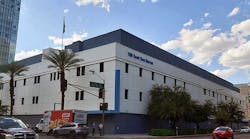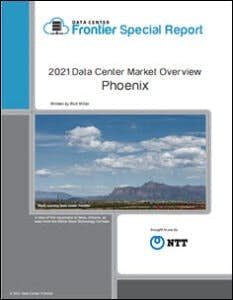Supply and Demand Trends in the Phoenix Data Center Market
Last week we launched a special report on the Phoenix data center market, showing how the region is positioned for continued data center expansion. This week, we’ll take a look at a few of the key trends in Phoenix, including what’s driving demand in the market and how the region is boosting supply.
Download the full report.
TRENDS IN DEMAND
Demand in Phoenix originates both from companies in the market and companies in other areas that favorably view the Phoenix market as a primary or disaster recovery location. When compared to other major U.S. data center markets, Phoenix is very competitive on colocation rates, power cost, and tax incentive opportunities.
These market attributes enable Phoenix to compete for data center requirements, with the largest deals coming from hyperscale deployments. Other companies consistently searching the Phoenix market include those in the e-commerce, financial, insurance, healthcare, and technology industries.
The Exodus from California
Much of the opportunity for Phoenix is rooted in its status as a leading alternative to California, which boasts a large concentration of data centers. The California market has been roiled by the troubles of utility PG&E, which filed for bankruptcy protection in 2019 due to wildfire-related liabilities. The prospect of higher future utility bills, along with PG&E’s imposition of rolling service outages during periods of heightened wildfire risk, has customers looking beyond California’s borders for their West Coast data center workloads.
Phoenix is hardly alone as a destination for data center customers migrating out of California, as Las Vegas, Reno, Salt Lake City and the Pacific Northwest are other options. Some market watchers say firms migrating from Southern California typically look to Phoenix and Las Vegas as options, while customers from the Bay Area are more likely to consider the Pacific Northwest.
The Impact of the COVID-19 Pandemic
It’s impossible to discuss demand trends without addressing the impact of the COVID-19 pandemic, as health concerns have driven a nearly overnight shift to online services for business and education. The societal shift to online services made 2020 an extraordinary year for the data center industry, with record leasing and a historic boom in the construction of new facilities, especially in Northern Virginia.
Leasing was less robust in Phoenix in 2020, with there have been some large deals, most notably a Fortune 100 customer pre-leasing 12-megawatts at Iron Mountain’s AZP-2 data center, achieved through two 6-megawatt deals. The first 6 MW lease will commence in 3Q 2021. The AZP-2 facility is an expansion of the former IO Data Centers project, which spans 41 MWs and 588,000 SF. Iron Mountain recently announced another 6 MW of leasing at AZP-2 from a Fortune 100 technology company, and market reports suggest demand has improved in early 2021, including more activity by enterprise companies.
Several trends tied to the pandemic figure to boost local demand. These include the focus on automation and autonomous driving, as Phoenix is an early deployment site for Google’s Waymo driverless ride service. The region also has an active cluster of genomics research, which is data-intensive and likely to see additional investment.
Cloud Platform Expansion Strategies
But perhaps the largest factor in data center growth in Phoenix will be trends in the architecture of cloud growth. Availability zones, which spread capacity across regions – and across multiple data centers within a single geographic market – are an increasingly important factor in cloud real estate. The strategy was developed by Amazon Web Services, but rivals Microsoft, Google and Oracle are rushing to create similar diversity in major markets.
According to the special report, there are several reasons that the focus on availability zones matter in Phoenix.
- A zone strategy may guide large customers to view site selection decisions about Western U.S. markets as “both/and” rather than “either/or”—specifically, that some cloud, video and SaaS providers are not choosing between Hillsboro and Phoenix, but could consider zones in both locations.
- It could also lead to cloud platforms placing more than one availability zone in Greater Phoenix, which applies similar logic to emerging choices between sub-markets—i.e., placing a facility in Mesa doesn’t rule out adding capacity either Downtown or in Goodyear.
- There is also the question of whether hyperscale players will build their own facilities or lease space from third-party wholesale data center developers. Google, Microsoft and AWS have all purchased land, so the presumption is that for now, Phoenix will be a “build” market.
It’s always possible that large customers will lease wholesale space to scale up while their new campuses are under construction, a trend seen in Northern Virginia. Microsoft already has a substantial leased footprint in Greater Phoenix.
TRENDS IN SUPPLY
From a geographic perspective, the present and future of the Phoenix market will look quite different. Most of the region’s colocation data center providers are located in Phoenix proper and Chandler, AZ, a city approximately 25 miles to the southeast of downtown Phoenix. A combination of lower electricity prices and real estate costs have lured data center providers, including Digital Realty, CyrusOne, and NextFort (acquired by H5) to create facilities designed to meet the needs of large users.
A Digital Realty-owned data center at 120 East Van Buren is also the prime carrier hotel in the downtown Phoenix market. Digital Realty purchased the property back in 2006 and has grown it to be among the largest in the market. Several other providers, including Iron Mountain, Cyxtera, and PhoenixNAP are located east of downtown Phoenix, near Phoenix Sky Harbor International Airport. In addition, other areas including Tempe, Scottsdale, and Deer Valley have several data center providers.
Phoenix has the highest planned data center capacity outside of Northern Virginia. The available power in the market is steadily shrinking, which may prompt some providers to move into the construction phase.
Going forward, the vast majority of data center investment in Phoenix will be built in the suburbs of Mesa to the East and Goodyear to the West. The two towns are each developing “data center districts” with targeted incentives and opportunity zones.
The intentional approach of local economic development officials has paid big dividends. There is currently 732 MW of capacity planned for Mesa, while 461 MW is planned in Goodyear.
In our next article, we’ll take a closer look at how data centers are expanding beyond Phoenix proper and into the suburbs.. Download the full report, 2021 Data Center Market Overview Phoenix, courtesy of NTT, to learn more about the Phoenix market. n>
About the Author




